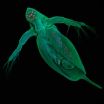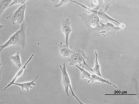(Press-News.org) MBL, WOODS HOLE, MA—The ubiquitous freshwater "water flea," Daphnia pulex, may be too small to see, but it has amply proven its value as an "sentinel species" for the presence of toxins and pollutants in the environment.
Daphnia's response to exposure to toxic metals and other chemical pollutants is well studied, and this information is routinely used by groups such as the US Environmental Protection Agency (EPA) to define regulatory limits, and to monitor industrial and municipal discharges.
This week, Daphnia pulex is receiving an enormous pat on the back from the scientific community: It is the first crustacean to have its complete genome sequenced. The sequence is being published Friday in Science magazine by members of the Daphnia Genomics Consortium, an international network of scientists led by the Center for Genomics and Bioinformatics at Indiana University-Bloomington and the Department of Energy's Joint Genome Institute.
Joshua Hamilton, senior scientist and chief academic and scientific officer at the Marine Biological Laboratory (MBL) in Woods Hole, Mass., is co-author of an important companion paper to the Daphnia genome sequence. That paper, published in 2007, was the first study of the genetic basis for Daphnia's adaptive response to sub-lethal levels of a major environmental contaminant, the metal cadmium. Cadmium, which is highly toxic to aquatic life (and to humans), is one of the most common contaminants found in the U.S. EPA Superfund sites.
The technologies described in the 2007 paper (cDNA microarrays) were the first genomic tools developed for Daphnia and they are applicable to testing Daphnia's genetic response to a wide range of environmental contaminants. Subsequently, many other environmental stressors have been tested using Daphnia.
"Daphnia can serve as an important 'canary in a coal mine' for freshwater ecosystems and their response to environmental contamination," says Hamilton. "When the Daphnia population is impacted, it is likely that the entire ecosystem is being adversely affected and may be on the verge of collapse."
Hamilton, then at Dartmouth Medical School, and colleagues at Dartmouth and Indiana University demonstrated that Daphnia can adapt to increasing levels of cadmium by up-regulating a unique version of a key protective molecule called metallothionein, but at a very high cost. Although the individuals could resist the high levels of cadmium and survive, their reproductive success plummeted to a fraction of that of animals in uncontaminated waters, which after only a few generations threatened the entire population's long-term survival.
Daphnia is emerging as a model organism for a new field of science—environmental genomics—that aims to better understand how the environment and genes interact. Scientific developments from this field can be used to manage our water resources and protect human health from chemical pollutants in the environment, and serve as a way to understand how our own bodies respond to these environmental challenges.
"Until now, Daphnia has primarily been used as sentinel species for monitoring the integrity of aquatic ecosystems," says Joseph Shaw, co-author of the cadmium study (as a former postdoctoral fellow with Hamilton), co-author of the new Science paper, and now a biologist at Indiana University-Bloomington's School of Public and Environmental Affairs. "But with many shared genes between Daphnia and humans, we will now also apply Daphnia as a surrogate model to address issues directly related to human health. This puts us in a position to begin integrating studies of environmental quality with research of human diseases."
INFORMATION:
To speak to Hamilton about importance of Daphnia pulex to environmental genomics, please contact Diana Kenney at 508-289-7139; dkenney@mbl.edu
RESOURCES
Citations:
Colbourne, J.K. et al. (2011) The Ecoresponsive Genome of Daphnia pulex. Science (Feb. 4, 2011).
Reporters may request a copy of the Colbourne paper, as well as supporting materials and Science's press package, at scipak@aaas.org
Shaw, J.R. et al (2007) Gene response profiles for Daphnia pulex exposed to the environmental stressor cadmium reveals novel crustacean metallothioneins. BMC Genomics 8: 477.
A PDF of the Shaw paper is available at: www.mbl.edu
The MBL is a leading international, independent, nonprofit institution dedicated to discovery and to improving the human condition through creative research and education in the biological, biomedical and environmental sciences. Founded in 1888 as the Marine Biological Laboratory, the MBL is the oldest private marine laboratory in the Americas. For more information, visit www.MBL.edu.
First crustacean genome is sequenced
'Water flea' is important indicator of environmental contamination
2011-02-04
ELSE PRESS RELEASES FROM THIS DATE:
University of Leicester releases stunning satellite imagery of cyclone Yasi from space
2011-02-04
Earth observation scientists at the University of Leicester have recorded stunning images of tropical cyclone Yasi by orbiting satellites.
Japanese Meteorological Agency and European Space Agency satellite instruments have been observing the intense storm over Australia from their vantage points in space.
University of Leicester scientists have used two instruments, MTSAT-2 and MERIS, which have enabled the scientists to follow the progress of the storm as it headed towards and then struck the Australian coast. They have provided unique views from space of a storm ...
Discovery may lead to turning back the clock on ovarian cancer
2011-02-04
Cancer researchers have discovered that a type of regulatory RNA may be effective in fighting ovarian cancer. Ovarian cancer isn't typically discovered until it's in the advanced stages, where it is already spreading to other organs and is very difficult to fight with chemotherapy. This new discovery may allow physicians to turn back the clock of the tumor's life cycle to a phase where traditional chemotherapy can better do its job.
Scientists at the Ovarian Cancer Institute Laboratory at the Georgia Institute of Technology have found in initial tests that a regulatory ...
Same rules apply to some experimental systems regardless of scale
2011-02-04
New experiments show that common scientific rules can apply to significantly different phenomena operating on vastly different scales.
The results raise the possibility of making discoveries pertaining to phenomena that would be too large or impractical to recreate in the laboratory, said Cheng Chin, associate professor in physics and the James Franck Institute at the University of Chicago. Chin and associates Chen-Lung Hung, Xibo Zhang and Nathan Gemelke published their results in the Jan. 26 Advance Online Publication (Feb. 10 print edition) of the journal Nature.
Chin ...
Rheumatoid arthritis researchers redefine remission
2011-02-04
ATLANTA – The American College of Rheumatology today announced the release of two new provisional definitions of rheumatoid arthritis remission, which are to be applied to future RA clinical trials.
According to research presented in the March issue of Arthritis & Rheumatism, a person with RA who is enrolled in a clinical trial would need to meet one of the following definitions to be considered in remission:
1. Tender joint count, swollen joint count (on 28 joint counts), C-reactive protein (in mg/dl), and patient global assessment scores (on a scale of zero to 10) ...
Microbiologists at TU Muenchen aim to optimize bio-ethanol production
2011-02-04
Food versus fuel -- this rivalry is gaining significance against a backdrop of increasingly scarce farmland and a concurrent trend towards the use of bio-fuels. Researchers at the Technische Universitaet Muenchen (TUM) are helping to resolve this rivalry: They are working to effectively utilize residual field crop material – which has been difficult to use thus far – for the industrial production of bio-ethanol. They took a closer look at bacteria that transform cellulose into sugar, thereby increasing the energy yield from plants utilized. If this approach works, both ...
New national study finds mountain bike-related injuries down 56 percent
2011-02-04
Mountain biking, also known as off-road biking, is a great way to stay physically active while enjoying nature and exploring the outdoors. The good news is that mountain biking-related injuries have decreased. A new study conducted by researchers at the Center for Injury Research and Policy of The Research Institute at Nationwide Children's Hospital found the number of mountain bike-related injuries decreased 56 percent over the 14-year study period (1994 to 2007) – going from a high of more than 23,000 injuries in 1995 to just over 10,000 injuries in 2007.
"The large ...
BU School of Public Health finds simple interventions reduce newborn deaths in Africa
2011-02-04
Training community birth attendants in rural Zambia in a simple newborn resuscitation protocol reduced neonatal deaths by nearly 50 percent – a finding that shows high potential to save lives in similar remote settings, a team of Boston University School of Public Health [BUSPH] international health researchers is reporting.
Findings published Feb. 3 in the BMJ by the team from the BU Center for Global Health and Development show that training and equipping Zambian traditional birth attendants to perform a neonatal resuscitation intervention led to a net reduction of ...
Analyzing long-term impacts of biofuel on the land
2011-02-04
Madison WI, FEBRUARY 03, 2011 – The growing development and implementation of renewable biofuel energy has considerable advantages over using declining supplies of fossil fuels. However, meeting the demands of a fuel-driven society may require utilizing all biofuel sources including agricultural crop residues.
While a useful biofuel source, crop residues also play a crucial role in maintaining soil organic carbon stock. This stock of organic carbon preserves soil functions and our global environment as well ensures the sustainable long-term production of biofuel feedstock.
In ...
New drought record from long-lived Mexican trees may illuminate fates of past civilizations
2011-02-04
WASHINGTON — A new, detailed record of rainfall fluctuations in ancient Mexico that spans more than twelve centuries promises to improve our understanding of the role drought played in the rise and fall of pre-Hispanic civilizations.
Prior evidence has indicated that droughts could have been key factors in the fates of major cultures in ancient Mexico and Central America (Mesoamerica). But there have been many gaps in the paleoclimate record, such as the exact timing and geographic extension of some seemingly influential dry spells.
The new, 1,238-year-long tree-ring ...
Helping feed the world without polluting its waters
2011-02-04
A growing global population has lead to increasing demands for food. Farmers around the world rely, at least in part on phosphorus-based fertilizers in order to sustain and improve crop yields. But the overuse of phosphorus can lead to freshwater pollution and the development of a host of problems, such as the spread of blue-green algae in lakes and the growth of coastal 'dead zones'.
A further issue is that phosphorus comes from phosphate rock, a non-renewable resource of which there are limited supplies in such geopolitically charged areas as Western Sahara and China.
Now, ...
LAST 30 PRESS RELEASES:
Tracing the quick synthesis of an industrially important catalyst
New software sheds light on cancer’s hidden genetic networks
UT Health San Antonio awarded $3 million in CPRIT grants to bolster cancer research and prevention efforts in South Texas
Third symposium spotlights global challenge of new contaminants in China’s fight against pollution
From straw to soil harmony: International team reveals how biochar supercharges carbon-smart farming
Myeloma: How AI is redrawing the map of cancer care
Manhattan E. Charurat, Ph.D., MHS invested as the Homer and Martha Gudelsky Distinguished Professor in Medicine at the University of Maryland School of Medicine
Insilico Medicine’s Pharma.AI Q4 Winter Launch Recap: Revolutionizing drug discovery with cutting-edge AI innovations, accelerating the path to pharmaceutical superintelligence
Nanoplastics have diet-dependent impacts on digestive system health
Brain neuron death occurs throughout life and increases with age, a natural human protein drug may halt neuron death in Alzheimer’s disease
SPIE and CLP announce the recipients of the 2025 Advanced Photonics Young Innovator Award
Lessons from the Caldor Fire’s Christmas Valley ‘Miracle’
Ant societies rose by trading individual protection for collective power
Research reveals how ancient viral DNA shapes early embryonic development
A molecular gatekeeper that controls protein synthesis
New ‘cloaking device’ concept to shield sensitive tech from magnetic fields
Researchers show impact of mountain building and climate change on alpine biodiversity
Study models the transition from Neanderthals to modern humans in Europe
University of Phoenix College of Doctoral Studies releases white paper on AI-driven skilling to reduce burnout and restore worker autonomy
AIs fail at the game of visual “telephone”
The levers for a sustainable food system
Potential changes in US homelessness by ending federal support for housing first programs
Vulnerability of large language models to prompt injection when providing medical advice
Researchers develop new system for high-energy-density, long-life, multi-electron transfer bromine-based flow batteries
Ending federal support for housing first programs could increase U.S. homelessness by 5% in one year, new JAMA study finds
New research uncovers molecular ‘safety switch’ shielding cancers from immune attack
Bacteria resisting viral infection can still sink carbon to ocean floor
Younger biological age may increase depression risk in older women during COVID-19
Bharat Innovates 2026 National Basecamp Showcases India’s Most Promising Deep-Tech Ventures
Here’s what determines whether your income level rises or falls
[Press-News.org] First crustacean genome is sequenced'Water flea' is important indicator of environmental contamination



